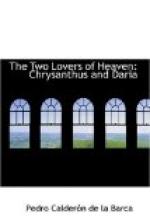12. See note referring to the auto, “The Sacred Parnassus”, Act 1, p. 21.
13. The asonante changes here into five-lined stanzas in ordinary rhyme. Three lines rhyme one way and two the other. Poems in this metre are called in Spanish ‘Versos de arte mayor,’ from the greater skill supposed to be required for their composition.
14. The asonante is single here, consisting only of the long accented o, as in “ROme”, “glObe”, “dOme”, etc.
15. Champion, or combater, the name generally given the Cid.
16. The metre changes to an irregular couplet in long and short lines.
17. The metre changes to the double asonante in e-e, which continues to the end of the drama.
18. Baptism by blood and fire through martyrdom. Calderon refers here evidently to the words of St. John the Baptist: “He shall baptize you in the Holy Ghost and fire”—St. Matth., c. iii. v. ii. The following passage in the Legend of St. Catherine must also have been present to his mind:
“Et cum dolerent, quod sine baptismo decederent, virgo respondit: Ne timeatis, quia effusio vestri sanguinis vobis baptismus reputabitur et corona”. Legenda Aurea, c. 167.
THE SPANISH DRAMA.
CALDERON’S DRAMAS AND AUTOS,
Translated into English Verse
by Denis Florence Mac-Carthy.
From Ticknor’s History of Spanish Literature. London: 1863.
“Denis Florence M’Carthy published in London (in 1861) translations of two plays, and an auto of Calderon, under the title of ’Love, the greatest Enchantment; the Sorceries of Sin; the Devotion of the Cross, from the Spanish of Calderon, attempted strictly in English Asonante, and other imitative Verse’, printing, at the same time, a carefully corrected text of the originals, page by page, opposite to his translations. It is, I think, one of the boldest attempts ever made in English verse. It is, too, as it seems to me, remarkably successful. Not that asonantes can be made fluent or graceful in English, or easily perceptible to an English ear, but that the Spanish air and character of Calderon are so happily preserved. Mr. M’Carthy, in 1853, had published two volumes of translations from Calderon, to which I have already referred; and, besides this, he has rendered excellent service to the cause of Spanish literature in other ways. But in the present volume he has far surpassed all he had previously done; for Calderon is a poet who, whenever he is translated, should have his very excesses, both in thought and manner, fully produced, in order to give a faithful idea of what is grandest and most distinctive in his genius. Mr. M’Carthy has done this, I conceive, to a degree which I had previously considered impossible. Nothing, I think, in the English language will give us so true an impression of what is most characteristic of the Spanish drama; perhaps I ought to say, of what is most characteristic of Spanish poetry generally".—tom. iii. pp. 461, 462.




